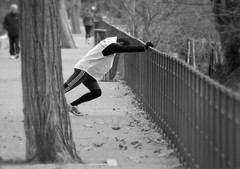Not before exercise;
It can improve strength/endurance and flexibility;
Concentrate on the tight muscles; and
It can improve joint stability at the knee and so help prevent knee injuries.

Here is another thing to bear in mind: Stretching before or after exercise does not prevent muscle soreness.
Many people stretch prior to or after engaging in physical exercise. Usually the purpose is to reduce the risk of injury, reduce soreness after exercise, or enhance athletic performance. Or that is what they will tell you if you ask them. Or maybe they just do it because everyone else does it.
Researchers looked at 10 relevant randomised trials looking at the effect of stretching before or after physical activity on muscle soreness. The studies produced very consistent findings - there was minimal or no effect on the muscle soreness experienced between half a day and three days after the physical activity. (The effects of stretching on other outcomes such as injury and performance were not examined in this review.)
"The best available evidence indicates stretching does not reduce muscle soreness. However there are other justifications for stretching," they wrote. "Some evidence suggests that once muscle soreness has developed stretching may provide a transient relief of soreness: some people stretch to reduce risk of injury, others stretch to enhance athletic or sporting performance, and yet others stretch because it gives them a sense of well-being. The current review does not provide any evidence of an effect or otherwise of stretching on risk of injury, performance, or well-being."
(If you are interested in some good articles on stretching and flexibility, look at Bryce's material here, or consider buying his booklet: "A Mighty River of Steel".)
Stretching to prevent or reduce muscle soreness after exercise
Background
Many people stretch before or after (or both) engaging in athletic activity. Usually the purpose is to reduce risk of injury, reduce soreness after exercise, or enhance athletic performance.
Objectives
The aim of this review was to determine effects of stretching before or after exercise on the development of post-exercise muscle soreness.
Search strategy
We searched the Cochrane Bone, Joint and Muscle Trauma Group Specialised Register (to April 2006), the Cochrane Central Register of Controlled Trials (The Cochrane Library 2006, Issue 2), MEDLINE (1966 to May 2006), EMBASE (1988 to May 2006), CINAHL (1982 to May 2006), SPORTDiscus (1949 to May 2006), PEDro (to May 2006) and reference lists of articles.
Selection criteria
Eligible studies were randomised or quasi-randomised studies of any pre-or post-exercise stretching technique designed to prevent or treat delayed-onset muscle soreness (DOMS), provided the stretching was conducted soon before or soon after exercise. To be eligible studies must have assessed muscle soreness or tenderness.
Data collection and analysis
Methodological quality of the studies was assessed using the Cochrane Bone, Joint and Muscle Trauma Group's methodological quality assessment tool. Estimates of effects of stretching were converted to a common 100-point scale. Outcomes were pooled in a fixed-effect meta-analysis.
Main results
Of the 10 included studies, nine were carried out in laboratory settings using standardised exercise protocols and one involved post-exercise stretching in footballers. All participants were young healthy adults. Three studies examined the effects of stretching before exercise and seven studies investigated the effects of stretching after exercise. Two studies, both of stretching after exercise, involved repeated stretching sessions at intervals of greater than two hours. The duration of stretching applied in a single session ranged from 40 to 600 seconds.
All studies were small (between 10 and 30 participants received the stretch condition) and of questionable quality.
The effects of stretching reported in individual studies were very small and there was a high degree of consistency of results across studies. The pooled estimate showed that pre-exercise stretching reduced soreness one day after exercise by, on average, 0.5 points on a 100-point scale (95% CI -11.3 to 10.3; 3 studies). Post-exercise stretching reduced soreness one day after exercise by, on average, 1.0 points on a 100-point scale (95% CI -6.9 to 4.8; 4 studies). Similar effects were evident between half a day and three days after exercise.
Authors' conclusions
The evidence derived from mainly laboratory-based studies of stretching indicate that muscle stretching does not reduce delayed-onset muscle soreness in young healthy adults.

2 comments:
My observation, which agrees with the report mostly except go further is that it can increase soreness given a few hours and reduce real flexibility.
I've seen dynamic flex work help (no quantification of this though) and oddly enough some -light- plyometrics seem to help.
Static forced stretching, I've never seen much positive come out of. Especially before races.
I don't think it's a great idea for a runner to feel all relaxed, loose and feeling zened out before a race. Want to feel relaxed and loose, light up a joint and go looking for snack cakes, won't help you win the race though.
Bryce
"Want to feel relaxed and loose, light up a joint and go looking for snack cakes"
Nice one Bryce :-)
Post a Comment